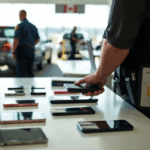Table of Contents
The ongoing murder trial of Karen Read has captivated public attention, particularly among younger audiences eager to understand the intricacies of legal proceedings. As the case unfolds, the courtroom has become a battleground for expert testimonies, digital forensics, and emotional narratives that resonate with a generation keen on justice and truth.
Expert testimonies shed light on critical evidence
In a recent session, the prosecution called upon Jessica Hyde, a digital forensic expert, to clarify the timeline surrounding key evidence in the case. Hyde’s testimony focused on Jennifer McCabe’s Google search regarding hypothermia, which the defense claimed occurred before John O’Keefe’s remains were discovered.
However, Hyde asserted that the search took place after the discovery, challenging the defense’s narrative. This revelation is crucial, as it could significantly impact the jury’s perception of the events leading up to O’Keefe’s death.
Hyde’s detailed explanation of smartphone forensics, including terms like “hex editors” and “hash values,” may have left some jurors bewildered.
Yet, her insistence on the scientific accuracy of her findings underscores the importance of digital evidence in modern trials. As the younger generation increasingly relies on technology, understanding these forensic details becomes essential in grasping the full scope of the case.
The defense’s strategy and courtroom dynamics
Defense attorney Robert Alessi’s cross-examination of Hyde revealed the tension in the courtroom. He questioned her credibility and the methodologies used in her analysis, aiming to dismantle the prosecution’s case.
Alessi’s approach highlights a common strategy in legal battles: to create doubt in the minds of jurors. However, as the trial progresses, it remains to be seen whether this tactic will resonate with a jury that is likely more attuned to the nuances of technology and its implications in legal contexts.
Moreover, the trial’s atmosphere has been described as tedious by some observers, with legal jargon potentially alienating jurors. David Gelman, a defense attorney following the case, noted that jurors often seek clarity and relevance, emphasizing the need for expert witnesses to communicate effectively. This dynamic reflects a broader trend in legal proceedings, where the ability to engage and inform jurors can be as critical as the evidence presented.
The implications of the trial for the Gen-Z audience
For Gen-Z and young adults, the Karen Read trial serves as a poignant reminder of the complexities surrounding justice and accountability. As the prosecution alleges that Read backed her SUV into O’Keefe after a night of drinking, the case raises questions about responsibility, the impact of technology on evidence, and the societal implications of such incidents.
The trial’s developments, including the introduction of digital evidence and expert testimonies, resonate with a generation that values transparency and truth. As the courtroom drama unfolds, it invites young adults to engage with the legal system, fostering a deeper understanding of how justice is served in contemporary society.
As the trial continues, the interplay between technology, expert testimony, and courtroom strategy will undoubtedly shape the outcome. For those following the case, it is a compelling narrative that underscores the importance of critical thinking and informed engagement in matters of justice.





